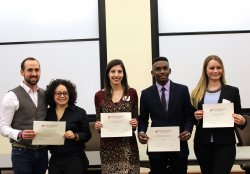Students Recognized at 9th Annual Research Symposium
David Lardier, Veronica Barrios, Evans Mbai, Melissa Rosides, & Monica Stanislawczyk took home awards for their research at this year’s symposium.
Posted in: Awards & Recognition, CSAM Research, CSAM Students

The 9th Annual Student Research Symposium, held Sunday April 26 2015, showcased over 230 presentations of more than 300 students’ research. The day’s events were broken up into blocks of oral and poster presentations spanning nearly 8 hours. For those whose presentations’ embodied an interdisciplinary style, spanning multiple disciplines, they were eligible for the symposium’s interdisciplinary awards. These awards were given to an undergraduate and graduate presentation in both the oral and poster categories. This year’s recipients are listed below.
To learn more about the Symposium, the rigorous requirements for these awards and the happenings of the day, visit the Student Research Symposium website!
Oral Presentation Awards
- A Family Therapist Matrix for Working with Adolescent and Sibling Substance Abuse (CEHS)
- Graduate Award
- David Lardier & Veronica R. Barrios
- Advisor: Dr. Jon Caspi
- Abstract: A robust body of research now demonstrates that siblings substantially influence human development. Siblings represent a uniquely significant source of socialization, influencing development in both beneficial and problematic ways. Sibling support has emerged as important for individual well-being, linked to many positive outcomes including lower rates of depression and isolation, and higher rates of life satisfaction and esteem. Siblings can also contribute to serious problems such as substance use, with similar influence to peers and more than parents. Although the benefits of including sibling relational concerns in substance abuse treatment has begun to emerge strategies for incorporating siblings have been lacking. Practitioners looking to research for treatment guidance discover two competing messages. The first is that close sibling relationships are highly beneficial for coping with difficult circumstances. The second is that close sibling relationships are linked to shared deviance, such as substance use. Should practitioners build closeness or distance when working with siblings and substance abuse? Family therapists must confront this sibling dilemma when engaged in adolescent substance abuse treatment. This paper presentation will review the research on sibling influence on individual development and their connection to substance use and abuse. A matrix will be presented to guide practitioners faced with the sibling dilemma described here. Empirically based strategies that incorporate siblings and sibling relational concerns in family substance abuse treatment will be offered.
- Bridging the 2nd & 3rd Dimensions (CART)
- Undergraduate Award
- Evans Mbai
- Advisor: Dr. Lauren Carr
- Abstract: My Student research project is in educating artists in finding a way to bridge the world of 2 Dimensional (2D) art and 3D Dimensional (3D) art. As the world becomes more and more digital, the majority of art is becoming created and viewed from a screen. One example in using 3D art for a 2D project like a comic is in the need for creating a setting. A well drafted background draws in the audience into the world the artist is creating. In place of struggling for hours with rulers laborious drawing techniques, simply modeling the space needed on the computer will open the artist to explore multiple perspectives leisurely. A 3D program can also be used in establishing good lighting. Good lighting is imperative in art! When executed properly, it can save many drawings. A 3D program can allow the artist to create a light source as reference for their scene. With a few clicks, the artist is able to adjust the type of lighting they want for their scene: be it day, night, cloudy, clear, foggy, ambient, etc. The two examples are simple techniques and yet incredibly time reducing ideas to be used. The implementations are endless. One of the great benefits of traversing multiple mediums is that it allows an artist to stay relevant with growing technology—making them more marketable in a brutally competitive field—while also permitting them to explore traditional medium without losing the intrinsic beauty of their personal touch.
Poster Presentation Awards
- SLP Graduate Students’ Perceived Preparedness to Work with Culturally & Linguistically Diverse Populations (CHSS)
- Graduate Award
- Melissa Rotsides
- Advisor: Dr. Valerie Johnson
- Abstract: As the population of the United States continues to grow, the process of diversification lends itself to a society that is increasingly heterogeneous in nature. An understanding of the complex interaction between language and sociocultural experiences is essential to the determination of whether a perceived language impediment is an innocuous byproduct of such processes or a true impairment. However, oftentimes the issue is not the recognition of how important appropriate service delivery is to culturally and linguistically diverse (CLD) populations – it is the realization of such a concept in training programs and its subsequent implementation in the field. Research findings have reported practicing speech-language pathologists’ (SLPs) perceived lack of resources, training, and confidence to work with CLD populations. Is this perceived self-efficacy a result of entering the field and being faced with unanticipated challenges? Or do graduate students also feel ill-prepared to work with CLD populations, even while approaching graduation and nearing completion of their respective training programs? To date, studies have not examined students’ perceived preparedness to work with CLD populations. The student’s perspective can help inform the development of training programs and is a valuable vantage point considering the bona fide importance placed on appropriate service delivery to CLD populations by both the American Speech-Language-Hearing Association (ASHA) and the government. The purpose of this poster is to: (1) examine student training outcomes and SLPs’ perceived self-efficacy, and (2) present the findings from a project’s examination of students’ perceived preparedness to work with CLD populations.
- FDA and the First Amendment Effects on Off-Label Drug Marketing (CHSS)
- Undergraduate Award
- Monica Stanislawczyk
- Advisor: Dr. Ian Drake
- Abstract: Do the Food and Drug Administration’s rules and practices regarding off-label marketing of pharmaceuticals violate the free speech protections of the First Amendment? Traditionally, the Food and Drug Administration has been viewed as a facilitator of safety and effectiveness in medicine. The extent of this role has been recently questioned with regards to the constitutionality of restrictions on off-label marketing of pharmaceuticals. The marketing of drugs for uses, age groups, or dosages other than what the drug is approved for by the FDA is considered off-label promotion. An interdisciplinary approach is required to gain a comprehensive understanding of the legal and public health ramifications if off-label marketing was to become legal. The research methods include collected analysis of both law and public health scholarly sources as well as primary sources in the form of statues and cases that reveal multiple theories and insights. This research will be presented through a poster medium, with a comparative disciplinary phenomena table outlining the viewpoints shared by each discipline and subsequently a common ground or possible solution column. This research concludes that the Food and Drug Administration’s rules and practices regarding the off-label marketing of pharmaceuticals violate the free speech protections of the First Amendment of the United States Constitution but that safety issues must be weighed and taken into consideration.
dl dt { font-weight: bold; margin-top: 1em; }
